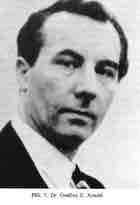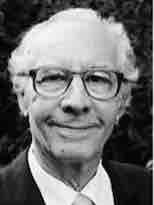Godfrey Edward Arnold
1914-1989


Godfrey Arnold studied with Hermann Gutzmann Junior at the University of Liepzig in Berlin. He also worked at the Voice and Speech Clinic, a branch of the Vienna Ear Clinic at the Vienna General Hospital. This hospital was affiliated with the University of Vienna. In 1939 when Froeschels and his associates were forced to leave Vienna because of the holocaust, Godfrey Arnold took his place as chief of the Froeschel’s phoniatric clinic.
Once the allies won, Arnold, himself, was forced to leave Vienna. He emigrated to the United States in 1949. Once here, he worked on the faculty of the New York Eye and Ear Infirmary of Mount Sinai Hospital and at J. S. Greene’s National Hospital of Speech Disorders, where he served as the hospital director and editor of Logo, a journal on various aspects of speech pathology published by the hospital.
Esti Freud, who knew Arnold in Austria and followed his career during the holocaust, describes him as a Nazi. When she was went to say goodbye to Froeschels at his clinic:
Dr. Arnold, a prominent Nazi at the Neumann Clinic threw me out by hand. Dr. Arnold is now a highly esteemed Ear, Nose and Throat specialist in Jackson, Mississippi (Freud, p. 56).
Esti played a strong role in Arnold’s life in the USA, blocking his effort to find work. In her memoir, she described her reporting of Arnold’s Nazi affiliation to the US authorities as follows:
Incident about Gottfried Arnold (p. 84)
I learned that Dr. Arnold, the Nazi of the Neumann Clinic who had succeeded Dr. Froeschels and had thrown me out of the outpatient department, had arrived in New York and was appointed at Bellevue Hospital. In Austria, after the breakdown of the thousand-year-old Reich, the Christian Social Party took over the government. All the prominent Nazis were fired from their jobs. Many came to the United States where they could get work. Froeschels wanted me to be quiet about Dr. Arnold, nevertheless, I went ahead and thus forced Dr Froeschels’ hand. We reported Dr. Arnold’s former activity to the authorities. I was investigated from all sides to determine if I were telling the truth. Anyway, to make a long story short, Dr. Arnold could not stay at Bellevue Hospital or even in New York City. At present he is professor at the university in Jackson, Mississippi. I am sure that by this action I made myself a great number of enemies. Tant pis.
An archive from the Jewish Telegraphic Agency describes the rejection of Arnold’s application for membership due to his Nazi affiliated past: https://www.jta.org/1955/01/26/archive/medical-society-refuses-membership-to-nazi-linked-applicant.
In 1949, together with Professor Dr. Richard Luchsinger of the University of Zurich, Arnold coauthored a textbook on voice and speech that was published in German and English. Between 1951 and 1963, he carried out studies in neurolaryngology. He established a method of successfully injecting of diced cartilage and later Teflon to improve vocal functioning in unilateral recurrent laryngeal nerve paralysis.
Between 1963 and 1979 Arnold served as chief of the Department of Otolaryngology at the University of Mississippi.
References
Arnold, G. (1955) Vocal rehabilitation of paralytic dysphonia: I. Cartilage injection into a paralyzed vocal cord, AMA Archives of Otolaryngology
Arnold G. (1955). Voice rehabilitation of paralytic dysphonia. II. AMA Arch Otolaryngol 62, 593–601.
Arnold G. (1957) Voice rehabilitation of paralytic dysphonia. III. Present concepts of laryngeal paralysis. AMA Arch Otolaryngol 65, 317-36.
Arnold, G. (1958) Vocal rehabilitation of paralytic dysphonia: IV. Paralytic dysphonia due to unilateral recurrent nerve paralysis AMA Archives of Otolaryngology, 68, 284-300.
Arnold G. (1959). Voice rehabilitation of paralytic dysphonia. V. AMA Arch Oto/aryngol 70, 444-53.
Arnold, G. & Heaver, L. (1959). Spastic dysphonia: Changing interpretations of a persistent affliction. Logos, 2, 3-14.
Gelb, H. & Arnold, G. (1959) Syndromes of the head and neck of dental origin: I. Pain caused by mandibular dysfunction AMA archives of otolaryngology, 70, 6, 681-691. doi:10.1001/archotol.1959.00730040695003
Arnold, G. & Heaver, L. (1959). Spastic dysphonia: Changing interpretations of a persistent affliction. Logos, 2, 3-14.
Arnold, G. (1960) Studies in tachyphemia I: Present concepts of etiologic factors. Logos, 3 25-45.
Arnold, G. (1960) Studies in tachyphemia III: Signs and symptoms. Logos 3 82-95.
Arnold, G. (1961) Vocal rehabilitation of paralytic dysphonia: VI. Further studies of intracordal injection materials. Archives of Otolaryngology, 73, 3, 290-294. doi:10.1001/archotol.1961.00740020298007
Arnold G. (1962) Voice rehabilitation of paralytic dysphonia. VII. AMA Arch of Olaryngol 75, 549-70.
Arnold G (1962). Voice rehabilitation of paralytic dysphonia. VIII. AMA Arch Otolaryngol 76, 76-83.
Arnold, G. (1962) Vocal rehabilitation of paralytic dysphonia: IX. Technique of intracordal injection Arch Otolaryngol. 76(4):358-368. doi:10.1001/archotol.1962.00740050368013
Arnold, G. (1962) Vocal rehabilitation of paralytic dysphonia: VIII. Phoniatric methods of vocal compensation. Archives of Otolaryngology, 76, 1, 76-83. doi:10.1001/archotol.1962.00740050080015
Arnold, G. (1962) Vocal nodules and polyps: laryngeal tissue reaction to habitual hyperkinetic dysphonia. Journal of Speech and Hearing Disorders, 27, 3, 205-217.
Arnold G. (1963). Voice rehabilitation of paralytic dysphonia. X. AMA Arch Otolaryngol 78 ,79–86.
Arnold, G. (1963) XXX Alleviation of Aphonia or Dysphonia: Through Intrachordal Injection of Teflon Paste Annals of Otology, Rhinology & Laryngology.
Luchsinger R, Arnold G (1965) . Voice-speech-language, 1st English ed. Belmont, California: Wadsworth Publishing.
Hogg I., Stephens C, Arnold G. (1972) Theoretical anomalies of the stapedial artery. Ann Otol Rhinol Laryngol. 81 860-870.
Arnold, G. (revised 2019) (Arnold’s article in Encyclopedia Brittanica on speech disorders: https://www.britannica.com/science/speech-disorder
